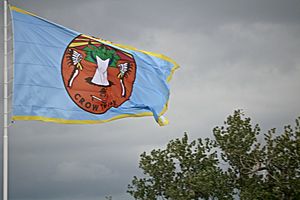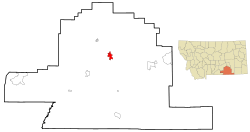Crow Agency, Montana facts for kids
Quick facts for kids
Crow Agency, Montana
|
|
|---|---|

Crow nation flag at Crow Agency
|
|

Location of Crow Agency, Montana
|
|
| Country | United States |
| State | Montana |
| County | Big Horn |
| Area | |
| • Total | 7.34 sq mi (19.01 km2) |
| • Land | 7.34 sq mi (19.01 km2) |
| • Water | 0.00 sq mi (0.00 km2) |
| Elevation | 3,038 ft (926 m) |
| Population
(2020)
|
|
| • Total | 1,657 |
| • Density | 225.75/sq mi (87.16/km2) |
| Time zone | UTC-7 (Mountain (MST)) |
| • Summer (DST) | UTC-6 (MDT) |
| ZIP code |
59022
|
| Area code(s) | 406 |
| FIPS code | 30-18250 |
| GNIS feature ID | 0770332 |
Crow Agency (Crow: awaasúuchia) is a special type of community in Big Horn County, Montana, United States. It's called a census-designated place (CDP). This means it's an area that looks like a town but isn't officially a city.
Crow Agency is very close to the Little Bighorn National Monument. This monument marks the site of a famous battle. The Real Bird family also puts on a reenactment of the Battle of the Little Bighorn nearby.
In 2020, about 1,657 people lived here. Crow Agency is the main government center for the Crow Native Americans. It's also where federal offices work with the Crow Tribe. This work follows special agreements and laws.
A part of the movie Little Big Man (1970) was filmed in Crow Agency.
Contents
Exploring Crow Agency's Location
Crow Agency is located at 45°36′5″N 107°27′35″W / 45.60139°N 107.45972°W. Interstate 90 runs right through the community. You can get there from Exit 509. U.S. Route 212 also passes through the town. A stream called Custer Creek flows next to the town.
The United States Census Bureau says that Crow Agency covers about 7.3 square miles (19.0 square kilometers). All of this area is land.
The Story of the Crow Agency Locations
The name "Crow Agency" has been used since 1868. It refers to the main office where the United States government worked with the Crow Tribe. This work was based on treaties and laws. The Crow Tribe's lands and their relationship with the U.S. government changed over time.
Early Crow Lands: No Agency Yet (1851-1868)
The Treaty of Fort Laramie of 1851 set aside large lands for Native American tribes. This was in Montana, Wyoming, and the Dakotas. At that time, few non-Native people lived there. A big area was given to the Crow Tribe. It was around the Big Horn Mountains.
This treaty did not set up specific agency sites. In 1851, the Crow Tribe lived a nomadic life. They hunted buffalo herds, including those in the Powder River area. Hunting there led to conflicts with the Sioux, who were moving west.
In 1863, gold was found in western Montana. Travelers used a route called the Bozeman Trail. This trail went through the Powder River country. Three forts were built to protect these travelers. The Sioux fought against the forts and travelers in "Red Cloud's War." This war made the U.S. government agree to close the forts. It also led to new boundaries for the Crow and Sioux lands in 1868.
The First Crow Agency (1868-1874)
The "Treaty with the Crows, 1868" recognized the Sioux moving into the Powder River Basin. This treaty gave the Sioux that area for hunting. The Crow's 1868 treaty moved their main lands west of the Powder River Basin. It placed them in the western Yellowstone Valley.
The treaty promised support from the government. It also said the Crow would have an agency "on the south side of the Yellowstone, near Otter Creek." This is close to today's Big Timber, Montana. The first Crow Agency was built around 1869-1874. It was about eight miles east of Livingston, Montana on Mission Creek. It became known as Fort Parker.
This first agency was in the western part of the Yellowstone River Valley. The Crow still hunted buffalo to the east. This often led to small conflicts with the Sioux.
The Second Crow Agency (1875-1884)
In 1874, miners started moving onto Crow lands. So, the reservation was made smaller in 1875. The first Crow Agency was now outside the Crow's land. Because of this, the agency moved east. The new site was just south of modern-day Absarokee, Montana.
The second Crow Agency (1875-1884) was still north of the Absaroka Range of Mountains. But it was about 66 miles further east than Fort Parker. It was on the Stillwater River, which flows into the Yellowstone River.
The years from 1875 to 1884 brought big changes to eastern Montana and Wyoming. In 1876, the Crow helped the U.S. military in the Great Sioux War of 1876. The Sioux defeated George Armstrong Custer at the Battle of the Little Big Horn in 1876. This led to a strong military response against the Sioux. By 1877 and 1878, many Sioux had either gone to Canada or were on reservations.
This made the Crow feel safer on their hunting grounds. But federal forts were built across the area. With fewer hostile Native American groups, buffalo hunters arrived. By 1882, the buffalo were almost gone from this area.
Also, in 1880, the Northern Pacific Railroad started building east. By 1882, their main line was finished. It followed the Yellowstone River valley. This happened just as the buffalo disappeared. Soon, large cattle herds arrived in Montana. They used the now empty plains for grazing. These quick changes ended the Crow's nomadic way of life.
The Third Crow Agency (1884 to Today)
In 1884, these events led to the final move of the Crow Agency. It moved to its current location at Crow Agency, Montana. This spot is 60 miles southeast of Billings. It is on the Little Bighorn River.
This move of over a hundred miles took the Crow people away from the Absaroka Mountains. It also moved them from the Yellowstone River valley. Their reservation center was now on the east side of the Big Horn Mountains. This was on the western edge of the Powder River Basin.
Crow Agency Population and Culture
| Historical population | |||
|---|---|---|---|
| Census | Pop. | %± | |
| 2020 | 1,657 | — | |
| U.S. Decennial Census | |||
Crow Agency is home to many Crow people. In 2000, about 55% of people spoke the Crow language at home. About 45% spoke English.
The Annual Crow Fair is a big event held here. It happens every third weekend in August. The Crow Fair is known as "The Teepee Capital of the World." During the celebration, as many as 1,500 teepees can be seen. They are set up across the river valley of the Little Big Horn River.
The PBS show Reading Rainbow filmed an episode here. It was called "The Gift of the Sacred Dog." This episode was filmed on June 17, 1983.
Famous People from Crow Agency
- Tuff Harris, a Pittsburgh Steelers safety, was born here.
- Clara Nomee, who used to be the Chairwoman of the Crow Nation, was born here.
- Jonathan Maxwell Beartusk, a Solar Artist, was born here.
Learning in Crow Agency
Crow Agency has an elementary school for younger students. Older students, from 9th to 12th grade, attend Hardin High School. Crow Agency is also home to Little Big Horn College. This college offers higher education.
Crow Agency's Weather
Crow Agency has a semi-arid climate. This means it's usually dry. The town gets about 41 inches of snowfall each year.
| Climate data for Crow Agency, Montana | |||||||||||||
|---|---|---|---|---|---|---|---|---|---|---|---|---|---|
| Month | Jan | Feb | Mar | Apr | May | Jun | Jul | Aug | Sep | Oct | Nov | Dec | Year |
| Mean daily maximum °F (°C) | 33 (1) |
38 (3) |
48 (9) |
61 (16) |
71 (22) |
81 (27) |
90 (32) |
88 (31) |
77 (25) |
65 (18) |
48 (9) |
38 (3) |
62 (17) |
| Mean daily minimum °F (°C) | 6 (−14) |
10 (−12) |
20 (−7) |
31 (−1) |
40 (4) |
48 (9) |
53 (12) |
50 (10) |
41 (5) |
31 (−1) |
20 (−7) |
11 (−12) |
30 (−1) |
| Average precipitation inches (mm) | 0.8 (20) |
0.7 (18) |
1.1 (28) |
1.7 (43) |
2.4 (61) |
2.4 (61) |
1.1 (28) |
1 (25) |
1.5 (38) |
1.3 (33) |
0.9 (23) |
0.8 (20) |
15.4 (390) |
| Source: Weatherbase | |||||||||||||
See also
 In Spanish: Crow Agency (Montana) para niños
In Spanish: Crow Agency (Montana) para niños


